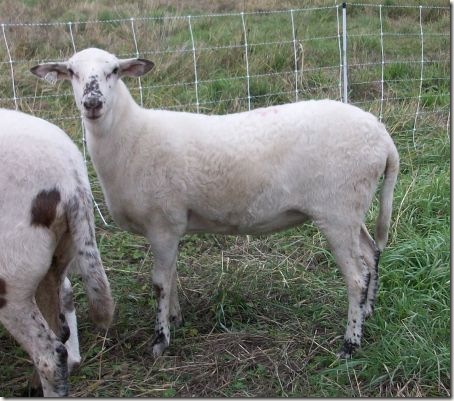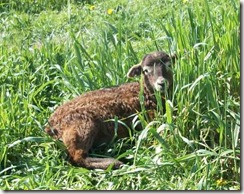 Udders have been on my mind the past few weeks. Our 7-month old ewe lambs were still nursing on their overly indulgent mothers. I will be separating the ewes in a few weeks, because the ewe lambs are going to pair with a different sire than the older ladies. I figured it would be good to get weaning out of the way before then; both so the mothers could start adding some condition (though none of them are thin!) and so the ewe lambs wouldn’t be stressing about weaning during the week they should be breeding. So, a few weeks ago, I split the hotwire enclosure into two halves.
Udders have been on my mind the past few weeks. Our 7-month old ewe lambs were still nursing on their overly indulgent mothers. I will be separating the ewes in a few weeks, because the ewe lambs are going to pair with a different sire than the older ladies. I figured it would be good to get weaning out of the way before then; both so the mothers could start adding some condition (though none of them are thin!) and so the ewe lambs wouldn’t be stressing about weaning during the week they should be breeding. So, a few weeks ago, I split the hotwire enclosure into two halves.
Category: Livestock
Marketing Our Hair Sheep and Lamb
 Here are some notes I had on a marketing presentation I heard at the KHSI Expo in Oregon. Dr. Charles Parker has a long background in livestock research, and he spoke on the future of the lamb industry in this country, and how we should be thinking about marketing our product.
Here are some notes I had on a marketing presentation I heard at the KHSI Expo in Oregon. Dr. Charles Parker has a long background in livestock research, and he spoke on the future of the lamb industry in this country, and how we should be thinking about marketing our product.
So, first off, the future generally looks very bleak! The U.S. lamb industry is actually on an eighty-year severe decline!
Sheep “Shipping Fever” – No Good End

I mentioned that one of my new sheep seemed to be feeling under the weather the first few days after I got her home. But after giving her some liquid nutrient as a pick-me-up and immune system support, she seemed to recover, and I saw her grazing, chewing her cud, and generally looking fine by the end of the week. I check on all our animals daily, so am quick to observe any problems.
Last Friday evening, I noticed she was hanging her head again, and seemed thinner, with runny eyes and new diarrhea. Continue reading “Sheep “Shipping Fever” – No Good End”
Parasite Control in Sheep and Goats
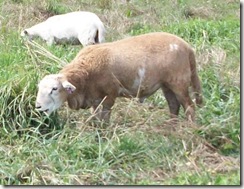 Ok, I have notes from three more speakers I heard at the KHSI Expo in Corvallis. Dr. Jim Miller addressed parasite control; he is from the Veterinary Medical School at Louisiana State University. He is also one of the founders of the Southern Consortium for Small Ruminant Parasite Control.
Ok, I have notes from three more speakers I heard at the KHSI Expo in Corvallis. Dr. Jim Miller addressed parasite control; he is from the Veterinary Medical School at Louisiana State University. He is also one of the founders of the Southern Consortium for Small Ruminant Parasite Control.
OPPV News at the KHSI Expo
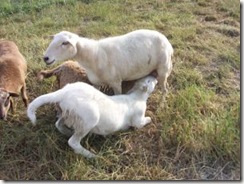 I still have more notes to share from the KHSI Expo! Another speaker we heard from was Dr. Lynn Hermann-Hoesing, from the USDA-ARS-Animal Disease Research Unit at Washington State University. Her team is doing research on Ovine Progressive Pneumonia Virus, or OPPV. It is a costly disease that is likened to AIDS in humans- slowly progressive, it robs ewes of thriftiness, and eventually leads to premature death.
I still have more notes to share from the KHSI Expo! Another speaker we heard from was Dr. Lynn Hermann-Hoesing, from the USDA-ARS-Animal Disease Research Unit at Washington State University. Her team is doing research on Ovine Progressive Pneumonia Virus, or OPPV. It is a costly disease that is likened to AIDS in humans- slowly progressive, it robs ewes of thriftiness, and eventually leads to premature death.
One in five sheep in the U.S. are infected, and one in three on the open range. There is correlation to flock size, larger flocks have a higher incidence of OPPV. It is estimated that OPPV costs the sheep industry about $2.7 million annually in lost productivity. The problem with OPPV is that it is often not overtly noticeable to the shepherd, but a flock will experience a smaller, less healthy lamb crop, and ewes that do not live a normal life span. So, the disease is of grave concern to the industry, and is often referred to as the “silent thief.”
New Ewes
At the Katahdin Hair Sheep International Expo in Oregon, they held an auction-style sale. This was a great opportunity to purchase some sheep that are from different bloodlines than the ones we have commonly in our area. It would have been ideal to purchase a ram there, but since I already have two rams that I can use for the next couple of years, it didn’t seem justified getting a third one for my small flock. So, I went with the intention of getting some ewes at least, to diversify the genetics I have.
Last KHSI Notes on Grass: RCG in the Northwest
My last bit of learning from Woody Lane’s class on grass actually happened at the lunch table. I had the good fortune of sitting by him, so got another whole hour of his knowledge! The topic of discussion was of great interest to me: reed canary grass (RCG), because we have a lot of it. The above picture is what our RCG looked like when we first started to tackle it, during the winter, it would lay in dead layers of brown like this. Beyond it, you can see a field of more “normal” green pasture grass that had been well-maintained by the prior property owner, cut for cow silage multiple times per season.
Continue reading “Last KHSI Notes on Grass: RCG in the Northwest”
What I Learned About Grass at the KHSI Expo: Part IV
Here is the fourth section of my notes on grass. Needless to say, I took a LOT of notes during Woody Lane’s lecture…
Continue reading “What I Learned About Grass at the KHSI Expo: Part IV”
What I Learned About Grass at the KHSI Expo: Part III
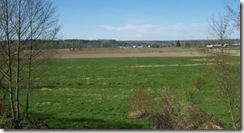 Here’s the third part of my notes from Woody Lane’s lecture on grass. This is intuitive once you say it and graph it; but grass, when it first starts growing, has the highest nutritional content it’s going to get. It’s TDN (total digestible nutrients) at this stage is likely in the low 70’s, percentage-wise. As it grows, it increases in volume, of course, but it also starts to decrease in TDN. When it’s headed out to seed, its TDN is down around 45%. So, there is an inverse relationship there, between increasing volume and decreasing nutritional value.
Here’s the third part of my notes from Woody Lane’s lecture on grass. This is intuitive once you say it and graph it; but grass, when it first starts growing, has the highest nutritional content it’s going to get. It’s TDN (total digestible nutrients) at this stage is likely in the low 70’s, percentage-wise. As it grows, it increases in volume, of course, but it also starts to decrease in TDN. When it’s headed out to seed, its TDN is down around 45%. So, there is an inverse relationship there, between increasing volume and decreasing nutritional value.
Continue reading “What I Learned About Grass at the KHSI Expo: Part III”
What I Learned About Grass at the KHSI Expo: Part II
 Here is a next bit of my notes from Woody Lane’s lecture on grass and nutrition. First, I should offer the caveat that he gave, which was that he felt he had to oversimplify some technical terms, due to the time constraints of the 2-hour class (which he normally teaches over several weeks). And, a second caveat that if something seems wonky in the information, surely it is my note-taking, and not Woody’s information, which is incorrect. 😉 Comments are welcome if I’ve gotten something wrong.
Here is a next bit of my notes from Woody Lane’s lecture on grass and nutrition. First, I should offer the caveat that he gave, which was that he felt he had to oversimplify some technical terms, due to the time constraints of the 2-hour class (which he normally teaches over several weeks). And, a second caveat that if something seems wonky in the information, surely it is my note-taking, and not Woody’s information, which is incorrect. 😉 Comments are welcome if I’ve gotten something wrong.
Woody introduced two terms which are important in considering what grazing animals need to eat in order to grow.
Continue reading “What I Learned About Grass at the KHSI Expo: Part II”
